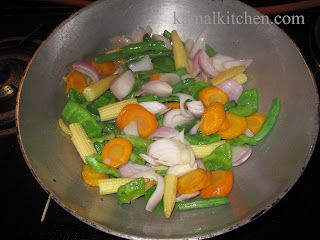
I think Thai food introduces some exotic factor into Asian cooking, and altho' it feels very familiar to the Indian palette in some aspects, there are just two or three typical ingredients that take it over the top. For a vegetarian, eating Thai food in a restaurant can be a challenge. It took me some time to realize why this much liked food often made me sick - addition of fishy ingredients, literally, such as shrimp powder or fish sauce. You have to always remember the special instructions, namely, no fish sauce, dried shrimp or eggs in anything, and if you ever forget this, you end up wasting a fine order of food. It is also tough to find ready-made thai pastes that cater to this requirement, some just don't list out the shrimp powder etc. There are some high-end brands such as those available at Whole Foods that will clearly label that this is suitable for vegans eg. But any ready made sauce in a bottle lacks the quality of freshly ground spices or pastes.
Now that I have made a case for making your own curry pastes, I am going to go ahead and post this recipe with a ready made paste I luckily found in the local store that was vegan. A readymade paste will generally make your red curry really red, or the green really green due to the addition of colour. But I am also giving the recipe for making this paste at home with the disclaimer that you may not get a similar red colour, and thats OK.
After perusing several websites, food tv, chef's sites, blogs etc. and of course my own experiences tasting red curry a million times, I have come up with the main elements that go into a thai curry paste. These are shallots/onions, ginger or galangal, garlic, kafir lime leaves or lemon zest, lemon grass and chillies. A red chilli gives you the red curry, the green gives the green curry, and most everything else remains the same. The sauce is generally made up of coconut cream or milk. I generally use the above ingredients by the 'eyeball' method, not being exacting in using measurements, and almost always add a stock of lemon grass to the boiling sauce, to get more flavour that way. My efforts generally end up tasting 'thai' like enough, for me to have made this multiple times.
You can use your choice of vegetables - carrots, broccoli, green beans, peppers, tofu etc. The recipe/method is as follows -

Ingredients -
2-3 medium onions
1 cup green beans
1 cup sliced carrots
1 cup diced peppers any color
1 cup broccoli florets
1 cup mushrooms optional
1 cup baby corn
1 pack tofu diced
1 can coconut milk
1 -2 tsp oil
salt and pepper
Curry paste -
3-4 Tbsp ready made paste from bottle
or
1 medium onion
12-15 fresh red chillies
1 head garlic
2 inch ginger
zest and juice of 1 lemon
stem of 3-4 stalk lemon grass
salt
1) If you are using your own curry paste, roughly chop above ingredients and grind to a smooth paste and keep aside.
2) Slice carrots and onions, chop peppers, mushrooms and dice the tofu.
3) Heat the oil in a skillet and add the vegetables one by one. Add carrots, beans, peppers, onions and tofu.
4) Add the curry paste and fry together with the veggies. Check seasonings and add salt/pepper as needed. Add curry paste a little at a time and taste until you get the required heat level. The coconut will dull some of the heat.

5) Add the can of coconut milk. You can use low fat if you wish. Stir everything and bring to a boil. You can add a stalk or two of lemon grass while this simmers to get more herby flavour. Add some water if needed to get a sauce of the desired thickness.
 6) Serve hot with steamed rice.
6) Serve hot with steamed rice. This is a quick and easy recipe to make at home. The curry paste can be made in advance and stored in the refrigerator.














